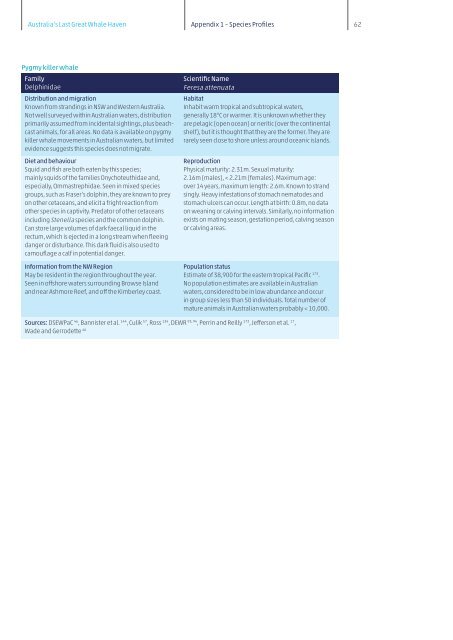Australia's last great whale haven.pdf - Ningaloo Atlas
Australia's last great whale haven.pdf - Ningaloo Atlas
Australia's last great whale haven.pdf - Ningaloo Atlas
- TAGS
- whale
- ningaloo
- atlas
- www.ifaw.org
Create successful ePaper yourself
Turn your PDF publications into a flip-book with our unique Google optimized e-Paper software.
Australia’s Last Great Whale Haven Appendix 1 – Species Profiles<br />
62<br />
Pygmy killer <strong>whale</strong><br />
Family<br />
Delphinidae<br />
Distribution and migration<br />
Known from strandings in NSW and Western Australia.<br />
Not well surveyed within Australian waters, distribution<br />
primarily assumed from incidental sightings, plus beachcast<br />
animals, for all areas. No data is available on pygmy<br />
killer <strong>whale</strong> movements in Australian waters, but limited<br />
evidence suggests this species does not migrate.<br />
Diet and behaviour<br />
Squid and fish are both eaten by this species;<br />
mainly squids of the families Onychoteuthidae and,<br />
especially, Ommastrephidae. Seen in mixed species<br />
groups, such as Fraser’s dolphin, they are known to prey<br />
on other cetaceans, and elicit a fright reaction from<br />
other species in captivity. Predator of other cetaceans<br />
including Stenella species and the common dolphin.<br />
Can store large volumes of dark faecal liquid in the<br />
rectum, which is ejected in a long stream when fleeing<br />
danger or disturbance. This dark fluid is also used to<br />
camouflage a calf in potential danger.<br />
Information from the NW Region<br />
May be resident in the region throughout the year.<br />
Seen in offshore waters surrounding Browse Island<br />
and near Ashmore Reef, and off the Kimberley coast.<br />
Scientific Name<br />
Feresa attenuata<br />
Habitat<br />
Inhabit warm tropical and subtropical waters,<br />
generally 18°C or warmer. It is unknown whether they<br />
are pelagic (open ocean) or neritic (over the continental<br />
shelf), but it is thought that they are the former. They are<br />
rarely seen close to shore unless around oceanic islands.<br />
Reproduction<br />
Physical maturity: 2.31m. Sexual maturity:<br />
2.16m (males), < 2.21m (females). Maximum age:<br />
over 14 years, maximum length: 2.6m. Known to strand<br />
singly. Heavy infestations of stomach nematodes and<br />
stomach ulcers can occur. Length at birth: 0.8m, no data<br />
on weaning or calving intervals. Similarly, no information<br />
exists on mating season, gestation period, calving season<br />
or calving areas.<br />
Population status<br />
Estimate of 38,900 for the eastern tropical Pacific 173 .<br />
No population estimates are available in Australian<br />
waters, considered to be in low abundance and occur<br />
in group sizes less than 50 individuals. Total number of<br />
mature animals in Australian waters probably < 10,000.<br />
Sources: DSEWPaC 46 , Bannister et al. 144 , Culik 57 , Ross 134 , DEWR 93, 94 , Perrin and Reilly 173 , Jefferson et al. 17 ,<br />
Wade and Gerrodette 46

















